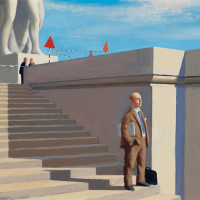20. JEFFREY SMART

The special psychological flavour of Jeffrey Smarts painting is singular. Much has been said about the formal sources of his work in art: he is a documented fan of the Old Masters and often refers in his own work to artists as diverse as Piero della Francesca (c1415-1492) and Paul Czanne (1839-1906). These references are sometimes obvious and even may be clearly stated in the titles of his work. The titles on occasion contradict or present a more subtle relationship between them. An example might be his Guiding Spheres (Homage to Czanne) 1979, one of his best-known paintings. The painting looks nothing like a Czanne and so we are obliged, if we want to gain a better understanding of the work, to go down the rabbit hole in search of associations. Smart relished the process and wanted to share it with us, without making it too easy.
Each of Smarts paintings exercises, through careful planning, his adherence to strict compositional technique including the principles of the Golden Section, the use of geometry, numerous studies and compositional versions for the systematic honing of a composition through trial and error, each a staging post of this journey marked by a more developed version, all of which demonstrate the controlled progress the artist makes as he resolves compositional niceties.
A collateral of this process is that in his works, nothing is left to chance. The figures that populate his works are anonymous and banal, just like his architecture. Even in his portraits, which invert the conventional relationship of the artist and his subject, Smarts disposition is to dilute the sitters personality, or at least to dilute the ego from his celebrity subjects. They are made ordinary. Smart has on occasion been criticised for his figures: not his best thing. The role of figure in his work is twofold: firstly, a person in a landscape will inevitably cause the viewer to focus on that aspect, drawing the eye down a path. Smart employs his figures for a particular purpose: through the use of glances, postures and gesture, which direct the viewers attention in a way that compliments the compositional dynamics generated by form, light, texture and colour. In this respect he displays the benefits of his study of Old Masters and his technique is almost conventional. The way the eye moves across and into the composition is Smarts way of engaging his audience in an active way. The viewer is visually stimulated which duly leads, however, back to an enquiry: what is the figure actually doing?
A figure standing Outside the Ministry would likely be a functionary, a cog in the wheel of society. He is anonymous as befits a person who exists in the arcane world of admin. For Smart he plays an important role in stabilizing a pictorial composition, arresting the downwards flow generated by the cascading steps. These steps: they represent one of Smarts highly sophisticated plays of light and shade. Through a coincidence of geometry and the shadow cast by the wall and the viewers perspective a line forms which mimics the pictures edge. It is an exactly parallel line. Elsewhere various shadows cast by the figure and the complexities of the masonry corner become a marvellous focus of another Smart tangle of angles and visual trickery. These subtleties to which Smart devotes an inordinate amount of effort relegate the punning of the figure and the monumental sculpture at his back to the merely obvious.
These highly evolved concoctions which Smart perfected over a long life found their highest form of expression in the late 1960s and through the 1970s. Outside the Ministry and the study for this work are demonstrations of Smarts skill in 1970, when he was at his best.
Timothy Abdallah BA